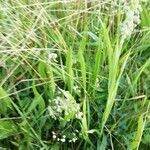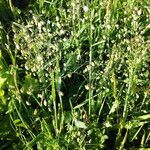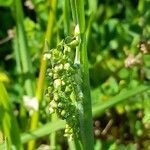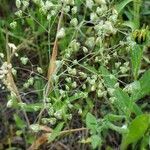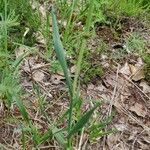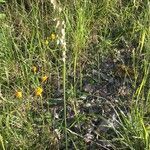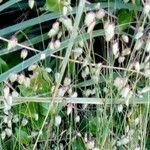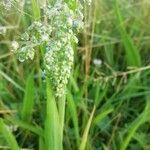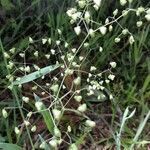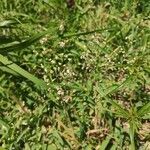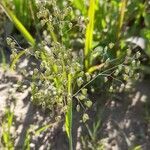Annual. Culms usually solitary, erect, slender, 20–60 cm tall. Leaf sheaths thin, soft, smooth, loosely overlapping; leaf blades thin, 4–12 cm × 4–10 mm, adaxial surface and margins scabridulous, apex acute; ligule 3–6 mm, subacute. Panicle open, erect, broadly ovate in outline, 5–10 cm, with many pendant spikelets; branches mostly paired, very slender, obliquely spreading, scabrid; pedicels hairlike, mostly longer than spikelets, flexuous. Spikelets broadly ovate, 3–5 × ca. 4 mm, pale green, florets 3–8; glumes broad, 2–2.5 mm, 3–5-veined, apex rounded; lemmas very broadly ovate, wider than long, lowest 1.5–2 mm, 7–9-veined, back smooth and glossy or pubescent, membranous margins very broad; palea ovate, slightly shorter than lemma, back appressed pubescentor marginal hairs spreading and fringing keels, keels almost wingless, glabrous. Anthers ca. 0.4 mm. 2n = 10.
Annual. Culms 7–23 cm high; mid-culm internodes solid. Leaf blades flat, 1.8–7 cm long, 2–4 (–7) mm wide, adaxially scabrous. Panicles open, oblong, 0.5–5.5 (–8.2) cm long. Spikelets broadly ovate, 2.5–4 mm long, with 4–6 bisexual florets; rachilla glabrous, without apical extension. Glumes ±equal, 2–3.5 mm long, usually green, sometimes purple-tinged; lower glume broadly obovate to elliptic, with margin hyaline, 3–5-nerved, with midnerve glabrous; upper glume broadly subulate, with margin narrowly hyaline, 5-nerved, with midnerve glabrous. Basal lemma broadly obovate to elliptic, 2–3.5 mm long, entire, muticous, 9-nerved, glabrous; nerves sometimes somewhat obscure. Palea slightly shorter than lemma, 1.75 mm wide, acute; nerves glabrous. Hilum punctiform.
Loosely tufted annual, 100-600(-700) mm high; culms soft with dark nodes, often branched near base. Leaf blade 40-220 x 3-9 mm; ligule an unfringed membrane. Inflorescence an open panicle, spreading, branches single or in fascicles of 2-4; spikelets > 20. Spikelet 3-5 x 3-6 mm, almost as wide as or slightly wider than length, awnless; glumes ± equal, shorter than spikelet, 3-5-nerved. Florets 4-8; lemmas obtuse, broad, cordate at base, entire, green, usually tinged with purple, margins distinctly lighter in colour, back papillose, glabrous; anther 0.3-0.5 mm long. Flowering time Sept.-Dec. Caryopsis 0.6 x 0.5 mm.
Annual.. Culms 10–60 cm. high, loosely tufted, erect or slightly geniculate, slender.. Leaf-blades narrowly lanceolate, 3–14 cm. long and 3–9 mm. wide, flat, minutely rough above and on the margins.. Panicles obovate, 4–20 cm. long, loose, prettily nodding, the numerous spikelets borne on capillary pedicels.. Spikelets 4–8-flowered, orbicular to triangular-ovate, 3–5 mm. long and as wide or wider, glabrous, shining, green or tinged with purple; lemmas 2–3 mm. long, very broad, deeply concave, hardened and shining in the centre but with broad white membranous margins.. Fig. 19/13.
Loosely tufted annual, 100-600(-700) mm high; culms soft with dark nodes, often branched near base. Leaf blade 40-220 x 3-9 mm. Inflorescence open, spreading, branches single or in fascicles of 2-4; spikelets more than 20. Spikelet 3-5 x 3-6 mm, almost as wide as or slightly wider than long, 3-8-flowered; glumes 3-5-nerved; glumes and lemmas green, usually tinged with purple, margins distinctly lighter in colour; lemma obtuse; papillose on back, glabrous; anther 0.3-0.5 mm long; caryopsis 0.6 x 0.5 mm.
Annual, loosely tufted (culms soft with dark nodes, often branched near base), up to 0.6 m high. Leaf blades 40-220 mm long, 3-9 mm wide. Spikelets 3-5 mm long, 3-6 mm wide. Panicle open, spreading, branches single or in fascicles of 2-4; spikelets numerous, almost as wide as or slightly wider than long, 3-8-flowered; glumes 3-5-nerved; glumes and lemmas green or tinged with purple, margins distinctly lighter in colour.
Annual 1–5 dm, the culms solitary or clustered; lvs 3–8 mm wide, rough on the margins and often also on the surface; ligule lanceolate, 3–6+ mm; infl 5–15 cm, lax, freely branched; spike lets numerous, triangular-ovate, 3–5 mm, 4–8-fld; glumes 2–3.5 mm, 3–5-veined; lemmas 1.5–2 mm; 2n=10. Native of Europe, occasionally found in waste places in our range from se. N.Y. southward.
Spikelets 3-5 x 3-6 mm., 4-8-flowered, triangular-ovate to circular in outline, pendulous, sometimes erect, green or occasionally tinged with purple, glabrous, somewhat glossy, 2-3·5 mm. long, 3-5-nerved, apex obtuse or sometimes bluntly acuminate.
Lemmas 2-3 mm. long, 7-9-nerved, deeply concave, apex broadly obtuse, dorsally rounded, indurated and glossy at the centre with broad whitish-hyaline margins.
Leaf-laminae 3-14 x 0·3-0·9 cm., narrowly lanceolate, tapering to a fine point, usually expanded, asperulous on the upper surface and along the margins.
Panicle 4-15(20) cm. long, obovate in outline, with many spikelets; branches spreading or obliquely ascending, scaberulous.
Culms 10-60 cm. tall, erect or more rarely geniculately ascending, 2-4-noded, slender, terete, glabrous, smooth.
Like B. maxima but spikelets more than 20 per panicle, ± as wide as long, to 5 x 6 mm.
Caryopsis c. 2·25 mm. long, light brown, ventrally flat, dorsally convex.
Paleas with the wings inconspicuously ciliolate.
Leaf-sheaths somewhat loose, rounded, smooth.
Pedicels 5-15 mm. long, capillary.
Ligule 3-6 mm. long, obtuse.
A loosely caespitose annual.
Anthers c. 0-6 mm. long.
